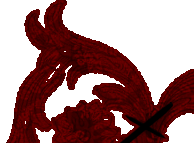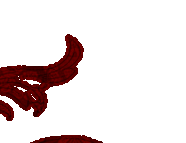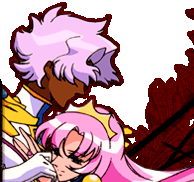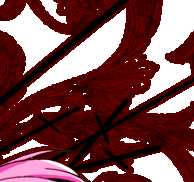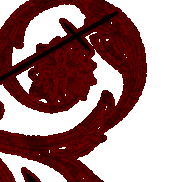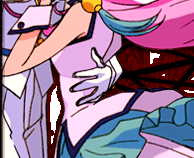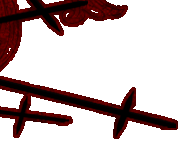
This analysis
was donated by mistspinner.
Surrealist Feminism Through a Jungian Analysis of Revolutionary Girl Utena
Revolutionary Girl Utena: Surrealist Jungian Feminism
Director Kunihiko Ikuhara's seminal 1997 anime, Revolutionary Girl Utena has variously
been described as post-modern fairytale, surrealistic Buddhist allegory, and feministic fantasy.
Of the above descriptors, much focus has been given to Utena's feministic themes – and with its
princess more capable than she appears, its princes ranging a spectrum from misguided to
malicious, and its protagonist a young girl desiring to be a prince, Utena's subversion of gender
roles is one of its most prominent features. In its rejection of traditional gender roles, many
critics have read Utena as a rejection of patriarchal institution – certainly a valid interpretation of
the text, given the series' subversion of gender roles, and one that would clearly support Utena's status as feminist surrealism.
At the same time, such a reading leaves out many of Utena's other themes and symbols.
Among them is Utena's heavy reliance on Jungian symbolism: with the series' heavy reliance on
archetypes and its explicit mention of such key Jungian concepts as the anima and animus,
analytical psychology is clearly a large influence in Utena's creation. Thus, an understanding of
Jung's ideas can be expected to add further insight into the series1. Using a Jungian lens, themes
of projection and adaptation emerge, complexifying the series' feministic themes and
problematicizing a reading of the series as a purely feministic work.
Thus, through a Jungian analysis, Revolutionary Girl Utena emerges as a series that
emphasis not simply the rejection of gender role, but rather the decidedly avant-garde theme of
the necessity of change.
 An Overview of Jungian Concepts
In order to analyze Utena in the context of Jungian philosophy, it is first necessary to
define some basic Jungian concepts: namely, the ideas of the archetype, the complex, and the
projection.
Contrary to its literary definition, archetypes in Jung are not so much particular tropes,
but rather particular "possibilities of representation" for tropes2. Just as all deities in Hinduism
are representations of a supreme god, an archetype is not a specific idea, but instead a specific
"mode of psychic functioning" from which manifests many specific archetypal images, or
symbols3. Symbols, then, are the observable manifestations of numinous archetypes. However,
what they gain in tangibility, symbols lose in flexibility; unlike the archetype, which can have
many forms, a specific symbol has a fixed form.
A potential effect of symbolic manifestation is the creation of a complex. Often formed
by past experiences, complexes are "clusters of related thoughts, feelings, memories and
impulses" that affect how people behave and see the world.4 A man with a savior complex, for
example, will see others as victims needing to be rescued and behave accordingly. In doing so,
he imposes the personal symbols of his complex onto the external world, a process termed
projection. While not necessary negative, projections nonetheless carries the risk of reduction: in
viewing people as symbols, personal complexities must be stripped away to yield a simplistic
and often inaccurate representation of others. As a result, Jung posits that healthy relationships
"requir[e] the withdrawal of projections" and "the modification of one's image of the other in the
light of reality" in order that "each person can be seen and valued as he or she is."5 Such a
relationship – one in which others are not mere symbolic projections of a complex, but rather
full, developed human beings – is viewed by Jung as "the prototype for all relationships."6 Yet
while symbols and complexes may change, archetypes cannot. As Jung himself states:
Not for a moment dare we succumb to the illusion that an archetype can be finally
explained and disposed of [....] The most we can do is dream the myth onwards
and give it a modern dress. And whatever explanation or interpretation does to it,
we do to our own souls as well, with corresponding results for our own well-
being. 7
With these concepts clarified, it is then time to examine their manifestation in
Revolutionary Girl Utena.
 Creating the Prince: Projection in Utena
Our story opens with the curtain rising on our eponymous protagonist – literally. In a
vignette presented as meta-story complete with narrator and rising stage curtain, the anime
illustrates the story of young Utena Tenjou, described by the narration as a "little princess"
whose parents had recently died. Dressed in a stereotypical princess's crown and voluminous
gown and drawn with her body as a featureless black shadow, Utena is rescued from her sorrow
by "a prince on a white horse," also featureless, who comforts her. Admiring her nobility of
spirit, the prince gives her a ring that he promises will lead her to him – but instead of remaining
a princess and following the prince, Utena is inspired to become a prince herself.
In this sequence, repeated multiple times over the course of series, one finds one of the
main projections in Utena: traditional gender roles. By representing Utena and her prince – later
revealed to be Prince Dios – as faceless silhouettes, Ikuhara strips his characters of individual
characteristics, thus allowing them to be viewed as more universal, archetypal figures. With their
lack of individual features, what defines these characters primarily is their clothing: in her dress,
Utena acts as the helpless princess, while Dios's military garb marks him as the prince who must
save her. By their association with traditional prince and princess roles, Utena and Dios then
respectively embody the ideal of helpless femininity and masculinity. However, as the sequence
proceeds, this heteronormative ideal is interrupted: by taking on the prince's clothing, Utena also
takes on the prince's role of powerful masculinity.
Directly after this sequence, we see Utena at fourteen, attending the prestigious Ohtori
High School and wearing a boy's uniform. With her masculine garb and proficiency at athletics,
Utena initially appears as a traditional tomboy – yet at the same time, she refuses to deny her
own femininity, empathetically telling the male basketball captain that she will not join their
team because she "happen[s] to be a girl" who would rather not associate with "a bunch of
stinking, sweaty boys"8. For Utena, her appropriation of masculine garb is not born out of a
desire for maleness, but rather out of her childhood encounter with Dios – retaining Dios's ring,
Utena explains that she wears the boys' uniform in order to be "noble prince who saves
princesses."8 Thus, Utena's appropriation of a masculine role emerges as an external projection of
what could be termed a prince complex.
The constructed role of the prince/princess dynamic is further emphasized when Utena
becomes involved in the Rose Bride duels, a series of swordfights determining possession of the
eponymous Rose Bride, Anthy Himemiya. A demure, passive girl, Anthy appears as "the
stereotypical damsel in distress" princess to Utena's prince – a role further emphasized when
Utena, after defeating Anthy's previous "master," becomes "engaged" to the Rose Bride.8 The
nature of the duels itself reflects the archetypal nature of Anthy and Utena's relationship. Upon
entering the dueling arena, a platform overlooked by an upside-down castle, both "transform"
from their school uniforms into their dueling costumes: Anthy into a billowing princess's gown,
and Utena into a military uniform striking similar to Dios's attire. Thus clothed for their roles as
prince and princess, Utena and Anthy present an archetypal fairytale scene, complete with castle.
However, it is important to note that this is a constructed scene: Utena's transformation is
catalyzed by Anthy, who clothes Utena by running her hands over Utena's body. Anthy's role in
the duels then further points to the constructed nature of the prince/princess gender binary; when
placed in the context of Anthy's past, this role further cements the creation of prince and princess
as projection images.
As a young child, Anthy was the sister to Prince Dios; in context of the medieval setting
her story is presented in, this would traditionally make her a princess. However, instead of acting
as the passive princess, Anthy – upon seeing the suffering Dios's altruism bring him – actively
decides to take Dios from the villagers. As a result, she is labeled a "witch" by the villagers, who
proceed to impale her with their swords. Miraculously, however, Anthy survives, and her
survival – along with her supernatural ability to take on other characters' forms and cause body
swaps with her cooking, which parallel traditionally witchy powers of shape-shifting and potion
brewing – aligns her as an archetypal witch. As women with power and agency, witches are
feared and denigrated; as women without power, princesses are accepted. In the world of Utena,
women must fit into either one of these categories, and "a girl who cannot become a princess is
doomed to be a witch."9 As a character who acts in the role of both princess and witch, Anthy is
slotted into different categories by the duelists who battle over her according to their various
complexes: for innocent Miki, she is the pure and "shining thing" his promiscuous sister once
was; for controlling Saionji, she is the "something eternal" once found in former friend Touga;
for Utena, she is the princess who needs saving. From their emphasis on preservation of the past,
these differing views of Anthy can all be seen as projections of the duelists' various complexes.
The Rose Bride's role as vehicle for projection is further emphasized by the dueling arena's
castle, whose moniker as "the castle said to hold eternity" emphasizes the duelists' desires to hold
onto the past.10
The most potent of these projections, however, belongs to Dios. Like Anthy, Dios has
miraculously survived the presumably hundreds of years since the village attack, though in a
barely recognizable form. Abandoning his chivalrous ideals, Dios is reborn as Akio, the amoral
chairman of Ohtori who systemically rapes and abuses Anthy. The name "Akio" is emblematic
of this shift in personality: explicitly stated to be "derived from the name of [....] the Morning
Star, also known as Lucifer," it contrasts sharply with "Dios," which points to either the Spanish
"dios" or the Latin "deus," both of which mean "God."11 Like Anthy, Akio appears as a
bifurcated figure, a malicious manipulator who is outwardly a charming prince – and also like
Anthy, Akio is instrumental in the creation of the duels. Throughout the series, Akio is
constantly surrounded by projectors, a motif that points to his role in the duels: by the end of the
series, Akio is revealed as the mastermind behind the duels, manipulating Utena and the other
characters for his own purposes. In the penultimate episode, the dueling arena and castle are
revealed to be illusions created by Akio's projectors, making them literally a projection of his
interior state. Because of the castle's association with archetypal prince/princess relationships,
the normative gender ideals it purports then also become Akio's projection images. This is made
especially clear in the penultimate episode, when Akio responses to Utena's desire to know "what
[he is] after" by stating that he "dreams of the castle [....] where the Prince and the princess will
live happily forever and ever and ever after."12
Consequently, the gender roles in Utena – male/agency, female/helpless – are revealed as
projections created by Anthy and Akio, constructed structures with their basis in the past.
 A Storybook Coffin: the Dangers of Projection
Just as Jungian projections can be potentially unhealthy, the projections in Utena often
have deleterious effects. For Anthy, the projection of normative gender roles forces her to remain
the Rose Bride – a "doll without a heart" passed as a trophy among masters free to use or abuse
her as they wish.13 Her sole attempt to surpass this role, accomplished when she saves Dios,
results in severe retribution: after surviving the villagers' attack, she still bears the eternal
punishment of literal impalement by the "million swords that shine with human hatred."14 As the
Rose Bride, Anthy presents a graphic image of the deadly consequences of sustained projection –
in this case, the projection of normative gender roles.
In addition harming its receptor, projection is also negative for its creator. Anthy may be
directly harmed by projections, but the other characters' complexes prevent them from seeing the
world clearly and from growing personally. While projection causes distortion and stagnation in
all the character to an extent, its effects are especially exemplified by the character of Mikage. A
genius psychology student, Mikage manipulates other students into fighting Utena for the
purpose of overthrowing Anthy and installing Mamiya, the young boy Mikage loves, in her
place. Mikage's character, however, is thrown into question as figures from his past reappear:
Mikage was, it turns out, formerly Professor Nemuro, a researcher at Ohtori involved in a project
to "Find Eternity." This project, however, occurred "a long time ago," and yet Mikage's
appearance has not changed at all.15 Like Anthy and Akio, he retains his youthful appearance,
even as his former classmates age. Mikage's lack of physical change is mirrored by his
unchanging motivations – Mamiya, it turns out, is a figure from Mikage's past, a severely ill boy
whose mortality Nemuro sought to cure through his research. As a figure incredibly fixated on
the past, Mikage's unchanging appearance then mirrors his lack of personal growth; what could
be termed his eternity-complex prevents him from growing both physically and mentally. This
complex, however, also drastically distorts Mikage's view of the world: in the last episode of his
arc, it is revealed that the real Mamiya looked nothing the present edition and died many years
ago, that Mikage was actually in love with Mamiya's sister Tokiko, and that the Mamiya Mikage
interacts with in the present day is none other than Anthy. By holding onto the past, Mikage
loses the ability to view the present clearly; as a result, he becomes a pawn for Akio, who
ultimately discards Mikage when he is no longer useful. For Mikage, refusal to let go of the past
is correlated with both a physical death, in his disappearance from Ohtori, and a psychic death, in
his inability to grow.
This theme of death via complex is especially underscored by the series' usage of coffin
imagery. When the newly-orphaned Utena is first found by Touga and Saionji, she is hiding
inside a coffin, refusing to get out. "Being alive is kind of sickening," eight-year-old Utena tells
them, "why does everyone go on living knowing they'll end up dying anyway?"16 Unable to cope
with loss of her parents, Utena vows to "never leave [her] coffin," intending instead to die with
her parents.11 By holding onto her past with her parents, Utena is driven to suicide – a literal
death via complex. The correlation between complex and death is emphasized when Saionji,
noting how the various duelists are all trapped by their pasts, states that "we're all trapped in our
coffins."10
This brings us, then, to Utena's most prominent projection: the castle and the gender roles
it represents. While Utena may have eventually overcome her grief, Saionji states that "she's still
16 Revolutionary Girl Utena, episode 9.
trapped in the coffin."10 Because Utena still subscribes to the prince/princess binary, the prince
complex traps her in her role, as it also does with Anthy. As the character most prominently
affected by the prince complex, Anthy is also the one most obviously trapped by it: when the
castle is finally opened, what is inside is Anthy, ensconced within a coffin resembling the one
which once held Utena. In addition to the abuse it causes her, the prince-complex also traps
Anthy, keeping her in a coffin that prevents her physical growth and psychological escape.
With the negative effects of complex projection thus established, it is then time to turn to
the pivotal moment in the series: the death of the prince.
 Killing the Prince: Defiance of Archetypal Images
Finally realizing the agony Anthy suffers as the Rose Bride, Utena goes to the dueling
arena, where she finds and confronts Akio. There, Akio attempts to force Utena into her assigned
gender role: "I am the prince," he tells her, "and you, the princess."13 Utena, for the moment,
believes him – and as Akio takes Utena's sword, her princely clothing transforms into a dress in
the style of Anthy's gown. "Swords no longer suit you," Akio tells the prince-turned-princess, "I
shall keep this sword. And from this day forward, I will protect you."13 In taking Utena's sword,
Akio attempts to assign her to the castle-prescribed role for her gender: a helpless princess.
Remembering Anthy, however, Utena rebels – taking the sword from Akio, she vows to free
Anthy from him. Reappearing in princely garment, Utena rejects her role as a princess, defiantly
telling Akio that she is "going to be a prince!"13 The moment Utena says these words, the statue
of Dios breaks, the castle begins to crumble, and the projector starts to flicker off; in rejecting
her assigned gender role, Utena has destabilized both the castle and the gender norms it
represents.
Yet it is not enough. Utena may have proved that a girl can be a prince, but her
worldview still necessitates the binary of prince/princess, a fact Akio takes advantage of by
pushing Anthy at Utena. Anthy's prince, Utena instinctively takes a protective stance and pushes
Anthy behind her – whereupon Anthy, remembering her loyalties as the Rose Bride, stabs Utena
in the back. Leaving Utena, Anthy takes her place as the Rose Bride, pierced by the million
swords that are her eternal punishment. Utena's rejection of gender roles may have shaken the
foundations of Akio's castle, but because it continued to necessitate the ideal of gender roles, she
ultimately fails to destroy the castle. Instead, the projected prince-complex must be destroyed by
the destruction of the prince/princess ideal as a whole – and not solely by Utena, but by Anthy as
well. Determined to free Anthy, an injured Utena manages to stand up and open the coffin at the
heart of the castle. Inside, she finds Anthy, naked and free from any role her clothing would
assign to her. Utena "has met the full Anthy for the first time," and she is neither princess, prince,
nor witch.17 Yet instead of pulling Anthy out, Utena asks Anthy to take her hand, an act of
agency. Instead of passively being saved, Anthy must participate in her salvation, an act that
goes against the entire prince/princess paradigm – and only when Anthy rejects this ideal and
reaches her hand out, does the castle begin crumbling down.
In order to fully reject the prince-complex, however, Anthy must take full agency: just as
Utena is about to pull Anthy out of the coffin, their hands slip, and Anthy's coffin plummets
away. To destroy the castle, there can be no princes or princesses, a fact underscored by Utena's
statement that "in the end, [she] couldn't be a prince."15 With the princess gone, the swords head
for Utena, destroying the prince aspect of the prince-ideal before descending on the castle and
Akio's projectors, summarily "destroying the symbols of Anthy’s oppression."18 Only by
removing both the princess (Anthy) and prince (Utena) from the stage can the prince-ideal be
truly destroyed. By no means, however, is Utena dead – as Anthy tells Akio, "she is merely
vanished from [his] world."15 With its strictly defined prince/princess roles, Ohtori cannot contain
someone who fits into neither role, and thus Utena – with her princely role violently destroyed –
vanishes from the fairytale world Ohtori, presumably alive in the outside world where she is
neither prince nor princess, but a full person.
Newly-empowered, Anthy cannot exist in Ohtori, either – and so, with these words, she
leaves Akio and Ohtori, embarking for the outside world to search for Utena.
 A New Castle: Destruction and Integration of the Prince
Just because Utena ultimately reject the princely archetypal image does not mean,
however, that it rejects the archetype behind its creation as a whole. In a flashback, it is revealed
that when Dios rescued Utena, he told her the truth about Anthy. Moved by the sight of Anthy's
pain, Utena pleads with Dios to save her – and when he says he cannot, she declares that she will
become a prince to do so.10 The prince therefore becomes the shape Utena's compassion and
kindness takes, and while this shape is ultimately shown to be faulty, Utena's nobility is
ultimately the force that empowers Anthy to free herself. What Revolutionary Girl Utena offers
at its end, then, is not a rejection of the archetype (hence referred to as the "nobility archetype"),
but rather its specific manifestation in the form of the prince. From the ashes of the princely
archetypal image, a new one must be constructed that will better fit the needs of its users.
Within the Utena series, one sees the fitting of old archetypal images into new ones
through the changes in character dynamics at the end of the series. After the castle is destroyed,
the students at Ohtori seemingly resume their normal lives. However, the end of the series is not
a perfect mirror of its beginning: estranged twins Kozue and Miki now "practice piano together,"
jealous Shiori now "follows Juri as a friend with no apparent ill will," and former enemies Touga
and Saionji seem to have resumed their old friendship.19 Yet while Miki's sister-complex may no
longer bind him, that does not mean he has abandoned the desire for intimacy that drove it;
rather, he has managed to find a form to be that allows his past intimacy with Kozue to continue
into the present. The archetypal image may have changed, but the archetype that drove its
creation did not; it merely changed its shape. The evolution of archetypes point is further
supported by the lyrics to one of the duel songs, Paleozoic Within the Body:
The Oceanic You,
The Oceanic Me,
are the Paleozoic within the body.
Continuing to live,
continuing to die,
the Paleozoic telling the story.
[.....]
At the bottom of the sea, a grand history.
to the bottom of the sea, where I will be me. 20
Through the song's emphasis on the Paleozoic's continuing existence, one sees the continuation
of the enduring archetype, which continues "to live" and "tell the story" even as it evolves
through a myriad array of forms. In order to correctly serve its subject, however, this archetype
must necessarily change to allow continue to allow "I" to "be me."
While present in the series, it is within the Utena movie, Adolescence of Utena, that this
theme of evolution reaches its apotheosis. Like the series, the movie ends with the destruction of
the castle and the rejection of the norms it represents; unlike the series, however, as Utena and
Anthy escape to the new world on the back of a car, the movie shows them driving towards a
new castle. Yet in contrast to Akio's castle, this one is not upside down, but upright. The correct
alignment of the castle then illustrates that, in contrast to the old castle, it is a more situationally
correct manifestation of the nobility archetype; the fact that it is a castle shows that the nobility
archetype cannot be escaped. Just as Utena and Anthy create a new path amongst the rubble of
old obstacles, they create a new castle from the remnants of the old.
Thus, the obsolete archetypal image has vanished, but the archetype remains, reasserting
itself in a new, more topical form.
The overarching enemy of Utena appears then as not merely patriarchy, but rather fixed
representation. By refusing to change the archetypal image (the prince), the laudable traits
involved in its construction (altruism and compassion) twist themselves into a harmful shape,
buried in a castle that acts as coffin. Only when the original archetype is reformulated into a new
image (a new castle) can its original, beneficial effects manifest.

1 Seazer, J.A., "The Angel Androgynous," Shoujo Kakumei Utena Original Soundtrack 3, translated by
compact disc, http://ohtori.nu/audiology/translations/The_Angel_ Androgynous.txt
2 Jolande Jacobi, Complex/Archetype /Symbol in the Psychology of C.G. Jung, (New York: Princeton
Press, 1959), 52
3 Ibid, 43.
4 Mary Ann Mattoon, Jung and the Human Psyche, (New York: Routledge, 2005), 42.
5 Ibid, 94-5
6 C.G. Jung, The Archetypes and the Collective Unconscious, (New York: Princeton University Press, 1981), 160.
7 Revolutionary Girl Utena, episode 1.
8 Christy Gibbs, Breaking Binaries: Transgressing Sexualities in Japanese Animation. (PhD diss., The University of
Waikato, 2012).
9 Revolutionary Girl Utena, episode 34. Like the surrealist whore/mother dynamic, the witch/princesses binary can
be seen as a variant of the madonna-whore complex
10 Revolutionary Girl Utena, episode 9. 11 Revolutionary Girl Utena, episode 25. 12 Revolutionary Girl Utena, episode 38.
13 Revolutionary Girl Utena, episode 36.
14 Revolutionary Girl Utena, episode 39.
15 Revolutionary Girl Utena, episode 14.
16 Revolutionary Girl Utena, episode 9.
17 sharnii (user), "Priestess of the Perpetual Sacrifice," http://ohtori.nu/analysis/04_sharnii_priestess.htm.
18 seenathan (user), I just lurk (blog), March 18, 2013, http://seenathan.tumblr.com/post/45721711885/.
19 Kuraino, Azusa (user), "Anthy as Viewer's Mirror," http://ohtori.nu/analysis/04_azusa_anthy_mirror.htm.
20 Seazer, J.A., "Paleozoic Within the Body," Shoujo Kakumei Utena Original Soundtrack 1, translated by Robert
Paige, compact disc, http://ohtori.nu/audiology/translations/Paleozoic_Within_the_Body.htm.
 Bibliography Gibbs, Christy. Breaking Binaries: Transgressing Sexualities in Japanese Animation. PhD diss.,
The University of Waikato, 2012.
Ikuhara, Kunihiko. "Revolutionary Girl Utena." Be-Papas 1997. DVD
Jacobi, Jolande. Complex/Archetype /Symbol in the Psychology of C.G. Jung. New York:
Princeton University Press, 1959.
Jung, C.G. The Archetypes and the Collective Unconscious. New York: Princeton University
Press, 1981.
Kuraino, Azusa (user). "Anthy as Viewer's Mirror." Accessed June 10, 2013.
http://ohtori.nu/analysis/04_azusa_anthy_mirror.htm.
Mattoon, Mary Ann. Jung and the Human Psyche. New York: Routledge, 2005.
Seazer, J.A.. "The Angel Androgynous." Shoujo Kakumei Utena Original Soundtrack 3. KING
Records Co, Ltd. KICA-387. January 01 1998. compact disc,
http://ohtori.nu/audiology/translations/The_Angel_Androgynous.txt.
Seazer, J.A.. "Palezoic Within The Body." Shoujo Kakumei Utena Original Soundtrack 1. KING
Records Co, Ltd. KICA-354. July 24 1997. compact disc,
http://ohtori.nu/audiology/translations/Paleozoic_Within_the_Body.htm.
sharnii (user). "Priestess of the Perpetual Sacrifice." Accessed June 10, 2013.
http://ohtori.nu/analysis/04_sharnii_priestess.htm.
  |

